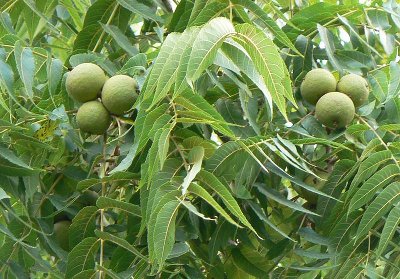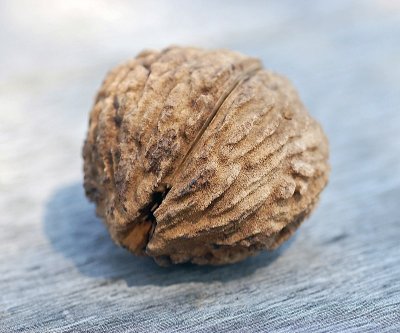Walnut
 Common Names: Walnut, English walnut, Persian walnut, black walnut
Common Names: Walnut, English walnut, Persian walnut, black walnut
Scientific Name: Juglans nigra
Climate: Moderate
Plant Description: The walnut is a round or oval-shaped crowned tree. The leaves are compound with 15-20 leaflets. They are green, oval and serrated. The leaves are about 30 cm long and ten centimeters wide. The walnut grows to about 15 meters high with a crown of about seven meters in diameter. The flowers are catkin and are about 12 centimeters long. The fruit has a green husk which turns black when ripe and contains the nut. The walnut tree has a smooth, silvery bark.
Cultivation: The walnut does not grow well in places with extremes of temperatures, either where it is very hot or very cold. It does not tolerate spring frosts, and is shade intolerant and needs full sunlight.
The walnut requires well-drained soil, to depths of about 1.5 m, otherwise it will grow much more slowly. The soil should be rich in organic material. The roots produce a toxic substance, so the trees should be planted in areas where you do not intend to plant pines, apples, potatoes, tomatoes, alfalfa or blackberries.
The nuts can be planted directly to the ground or planted as seedlings after a year. If planting nuts, you must ensure that they are not dry as they will not germinate. The average germination rate is 30-50%, so it is best to plant three nuts to ensure a result. It grows best in cleared areas, so mulch is a good way of controlling unwanted wild plants. They should be planted about ten meters apart. Pruning is important during the first three years of growth to ensure that the trees grow upright, at which point they should be about three meters tall.
The trees will begin to produce nuts between six and ten years after planting. If they are dried in a cool place, they will keep almost indefinitely.
 Uses: Walnuts have been linked to reduced risk of heart disease. The shell is used in preparations to treat infections of parasites and bacteria because of its antioxidant and antibacterial qualities. The nuts can be eaten raw or roasted and they can also be pressed for oil. They are commonly used in salads and desserts. Black walnuts are high in protein. There are indications that it has positive effects in treating certain cancers.
Uses: Walnuts have been linked to reduced risk of heart disease. The shell is used in preparations to treat infections of parasites and bacteria because of its antioxidant and antibacterial qualities. The nuts can be eaten raw or roasted and they can also be pressed for oil. They are commonly used in salads and desserts. Black walnuts are high in protein. There are indications that it has positive effects in treating certain cancers.
Black walnut timber is considered to be one of the most durable types of wood and it’s color makes it a popular choice for making furniture and floors.
Pests and Diseases: The biggest threat to the black walnut is the Thousand Canker Disease. This is caused by a fungus that is associated with the walnut twig beetle and will destroy a tree in about three years. It is believed that complete removal of the bark may eliminate the disease, but this is not 100% certain. Walnut leaf blotch is another disease which can also affect the leaves and fruit. Collection and disposal of fallen affected leaves will prevent spread.
The walnut caterpillar is the most destructive pest. The female lays her eggs on the underside of the leaves and the larvae consume them. Sticky traps can be applied to the trunk of the tree to prevent them moving to the branches.
References:
https://www.ag.ndsu.edu/trees/handbook/th-3-137.pdf
https://www.motherearthnews.com/organic-gardening/black-walnut-trees-zmaz81mazraw
https://www.healthline.com/nutrition/black-walnut
https://www.thelumbershack.com/pages/information
https://walnutcouncil.org/resources/growing-hardwoods/insects-and-diseases/
https://www.nrs.fs.fed.us/pubs/misc/walnut/p120_123.pdf
En español:Nogal
